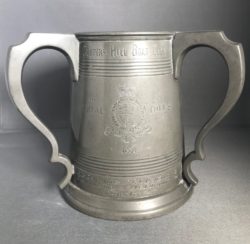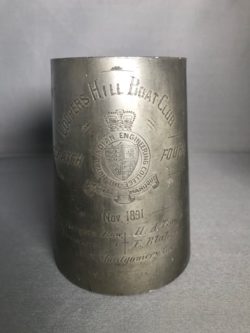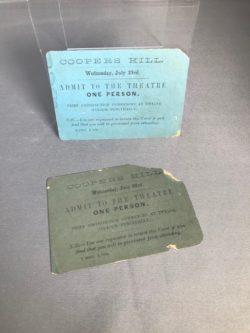A brief history of Coopers Hill
This article was inspired by a small collection of items found during our Collections Review, which were all linked to the Royal Indian Engineering College at Coopers Hill.
Those items were:

MC1297 – a trophy from Coopers Hill Boat Club 1887

MC767 – a trophy from Coopers Hill Boat Club 1891

Coopers Hill Theatre Tickets
12th to 19th century
1160: Abbot Hugh of Chertsey gave the site of Coopers Hill to the Priory of Ankerwyke.
1530: Henry VIII granted the estate to Andrew, Lord of Windsor in which it had become the manor of Parnish. . (Parnish/ Purnish: derived from ‘pernehos’, meaning a stubble of land marked by pear trees.)
1547: In the Crown Survey of 1547-1550, the first mention of the name “Cowper” appears. The “Cowper” family were known to be continual offenders against the Forest Laws. (Forest Law protected trees and games of forests that were under authority of the king. It was against the law to clear land, cut wood, hunt or carry bows and spears.)
1550: Edward VI gave the site to Sir Thomas Smith, Secretary of State.
1652: Coopers Hill was owned by John Lee in 1652, whose granddaughter married Simon Harcourt.
1700s: The estate was passed on by marriage to Simon Harcourt in the 18th century.
The estate remained in the family until it was bought in the 19th century by Baron Albert Grant, a financier. Grant is said to have had lavish entertainments which allegedly included a visit from the Prince of Wales. Following the financial collapse of Grant, the estate was put up for sale.
1870: Origins of the Royal Indian Engineering College:
In 1870, the estate was bought for the use as the Royal Indian Engineering College. (R.I.E.C) The story is said to be that the first president of the college from 1871-1880, Sir George Tomykns Chesney, had seen the empty building whilst boating on the Thames. The price paid for the estate was £55,000.
On the 5th of August 1872, the Royal Indian Engineering College was opened by the Secretary of State, the Duke of Argyle.
On the 4th of January 1875, Sir George Tomykns Chesney was informed by letter that Queen Victoria had approved that the College should in future be known as The Royal Indian Engineering College.
Student Life:
The building was converted to suit the College’s needs by Sir Matthew Digby Wyatt. The College had accommodation for 100 students at first and then later 150 students. There were four classrooms, a library, a lecture theatre, a model room, dining room and laboratory. (See floor plan)
The initial intake of R.I.E.C students was expected to worship each week in St Jude’s Church in Englefield Green. Apart from justifying this on spiritual grounds, Chesney considered this desirable because it would discourage students from staying up late on Saturday nights and spending Sunday mornings in bed. Once the College Chapel was completed in 1874 more frequent worship was required. Students had to attend a morning service on at least four mornings a week.
After the R.I.E.C was closed (1906), the stained glass windows were moved to Egham Parish Church- St Johns.
The students entered the service of the Government of India as engineers at a starting salary of £420 per annum.
The college was the first institution to introduce forestry courses.
The College Badge:
The College Badge consisted of the Royal Arms of England, displayed on a shield with the Royal Crown positioned above. The motto of the College was MENTE MANUQUE, meaning With Mind and Hand.
Links to India:
Sir George Tomkyns Chesney
From 1886 to 1892, Chesney was a military member of the governor-general’s council. He championed military reform, including ‘Indianization’, which proposed the admission of Indians into the higher (British) officer corps of the Indian Army. However, he was unsuccessful, perhaps due to the opposition of General Sir Frederick Roberts, the commander-in-chief of the Indian Army, who argued that the officer posts should be ‘properly reserved for the governing (i.e. British) race’.
Sir Alexander Taylor:
General Sir Alexander Taylor was the president of the college for 16 years, from around 1880 to 1896.
A statue of Taylor stood on the lawn in front of the President Block of Coopers Hill estate with the inscription, “A hero of the Indian Mutiny”. It was brought from Delhi in 1960 by his grandchildren and the Cooper’s Hill Society.
The statue of Alexander Taylor was removed in 2007 and is currently in storage.
Indian Uprising 1857:
You can find out more about the Indian Uprising in this article.
1906: Closure of R.I.E.C
Sir Alexander Taylor was succeeded by General Pennycuik, who was president of the college until 1900, and then Sir John Walter Ottley until its closure in 1906.
The R.I.E.C closed on the 13th of October 1906 after 31 years.
The estate was sold by the Government of India to Lord Cheylesmore and the work of the College was transferred to India under the name ‘Cooper’s Hill.’
1911:
Coopers Hill estate remained empty until it was sold on the 17th of January 1911 to Baroness Cheylesmore for use as a family home. The Cheylesmore family lived there until 1925 when Lord Cheylesmore was killed in a motor accident. The great ballroom that was being built at the time was left unfinished. The room today is known as Pillar Hall.
1938: The London County Council bought the estate as an emergency headquarters. The Records, Comptrollers and Motor-licensing departments were housed at Coopers Hill along with parts of the Education Department.
The statue of ‘Eros’ was removed from Piccadilly Circus and stored at Cooper’s Hill in a room still known as the ‘Eros Room’.
1946: The Cooper’s Hill Emergency Training College was founded by John E. Daniel. He died in 1948 and was succeeded by Mr H E Pacey. The college closed in 1951.
1951-1980: Shoreditch Training College/ College of Education
In 1901, the L.C.C established a Teacher-Training Department at Shoreditch Technical College in Pitfield Street, Hoxton. In 1919, the Board of Education gave the department the status of a training college.
By 1939, 150 students were taking a two year course either in the College or its Preparatory Department.
Following the expansion of teacher training after the Second World War, the number of students rose to nearly 300. The accommodation at Pitfield Street was not sufficient enough for the increase of students, thus the college was transferred to Cooper’s Hill in 1951. The two year preparatory courses were discontinued and a 3 year course became standard. The college continued to expand with new buildings formally opened on the 1st of May 1964. The number of students rose to 720.
In the 1970s, four year courses were introduced leading to London University degrees. The college offered teacher training courses in design and technology, an area in which there was a significant national shortage of teachers. Shoreditch College was responsible for around 20% of the national output each year of trained teachers in design and technology.
1980-2007: Brunel University
On the 1st of August 1980, Brunel University took over Cooper’s Hill, with a merger of Shoreditch College with the university. 375 teacher-training places were allocated to Shoreditch College within Brunel University, forming a campus of Education and Design.
In 2004, with rising maintenance costs, the department of Design under Brunel University moved from the Runnymede Campus to the main Brunel University campus at Uxbridge.
The site of Coopers Hill as the universities’ campus was abandoned altogether in 2007.
2019- Present day: Cooper’s Hill estate is currently the site of Audley Cooper’s Hill, a luxury retirement village of 78 apartments for over 55s.


